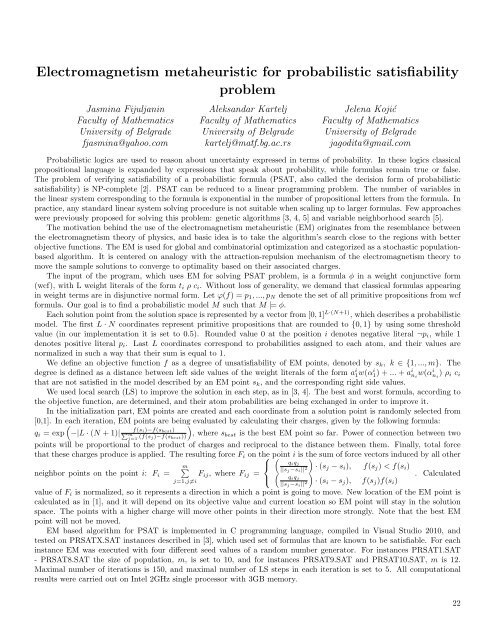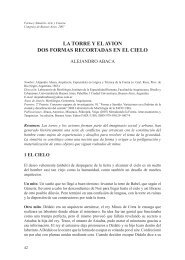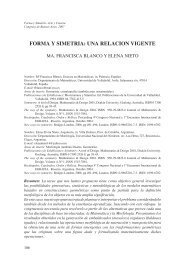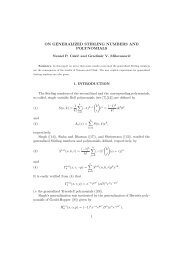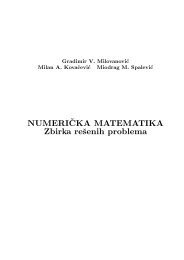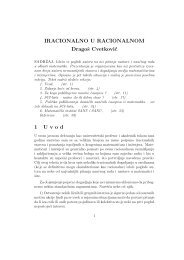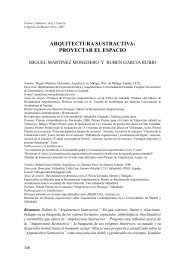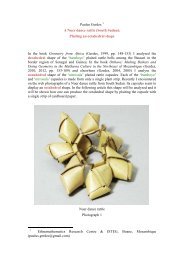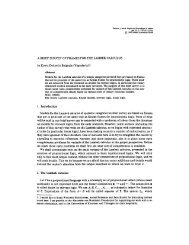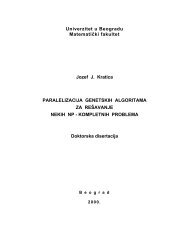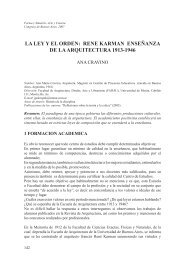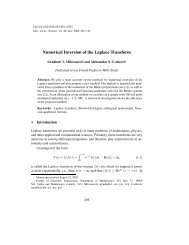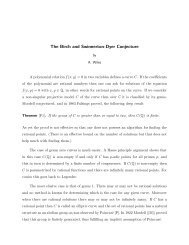Knjiga apstrakata - Mathematical Institute of the Serbian Academy of ...
Knjiga apstrakata - Mathematical Institute of the Serbian Academy of ...
Knjiga apstrakata - Mathematical Institute of the Serbian Academy of ...
Create successful ePaper yourself
Turn your PDF publications into a flip-book with our unique Google optimized e-Paper software.
Electromagnetism metaheuristic for probabilistic satisfiabilityproblemJasmina FijuljaninFaculty <strong>of</strong> Ma<strong>the</strong>maticsUniversity <strong>of</strong> Belgradefjasmina@yahoo.comAleksandar KarteljFaculty <strong>of</strong> Ma<strong>the</strong>maticsUniversity <strong>of</strong> Belgradekartelj@matf.bg.ac.rsJelena KojićFaculty <strong>of</strong> Ma<strong>the</strong>maticsUniversity <strong>of</strong> Belgradejagodita@gmail.comProbabilistic logics are used to reason about uncertainty expressed in terms <strong>of</strong> probability. In <strong>the</strong>se logics classicalpropositional language is expanded by expressions that speak about probability, while formulas remain true or false.The problem <strong>of</strong> verifying satisfiability <strong>of</strong> a probabilistic formula (PSAT, also called <strong>the</strong> decision form <strong>of</strong> probabilisticsatisfiability) is NP-complete [2]. PSAT can be reduced to a linear programming problem. The number <strong>of</strong> variables in<strong>the</strong> linear system corresponding to <strong>the</strong> formula is exponential in <strong>the</strong> number <strong>of</strong> propositional letters from <strong>the</strong> formula. Inpractice, any standard linear system solving procedure is not suitable when scaling up to larger formulas. Few approacheswere previously proposed for solving this problem: genetic algorithms [3, 4, 5] and variable neighborhood search [5].The motivation behind <strong>the</strong> use <strong>of</strong> <strong>the</strong> electromagnetism metaheuristic (EM) originates from <strong>the</strong> resemblance between<strong>the</strong> electromagnetism <strong>the</strong>ory <strong>of</strong> physics, and basic idea is to take <strong>the</strong> algorithm’s search close to <strong>the</strong> regions with betterobjective functions. The EM is used for global and combinatorial optimization and categorized as a stochastic populationbasedalgorithm. It is centered on analogy with <strong>the</strong> attraction-repulsion mechanism <strong>of</strong> <strong>the</strong> electromagnetism <strong>the</strong>ory tomove <strong>the</strong> sample solutions to converge to optimality based on <strong>the</strong>ir associated charges.The input <strong>of</strong> <strong>the</strong> program, which uses EM for solving PSAT problem, is a formula φ in a weight conjunctive form(wcf), with L weight literals <strong>of</strong> <strong>the</strong> form t i ρ c i . Without loss <strong>of</strong> generality, we demand that classical formulas appearingin weight terms are in disjunctive normal form. Let ϕ(f) = p 1 , ..., p N denote <strong>the</strong> set <strong>of</strong> all primitive propositions from wcfformula. Our goal is to find a probabilistic model M such that M |= φ.Each solution point from <strong>the</strong> solution space is represented by a vector from [0, 1] L·(N+1) , which describes a probabilisticmodel. The first L · N coordinates represent primitive propositions that are rounded to {0, 1} by using some thresholdvalue (in our implementation it is set to 0.5). Rounded value 0 at <strong>the</strong> position i denotes negative literal ¬p i , while 1denotes positive literal p i . Last L coordinates correspond to probabilities assigned to each atom, and <strong>the</strong>ir values arenormalized in such a way that <strong>the</strong>ir sum is equal to 1.We define an objective function f as a degree <strong>of</strong> unsatisfiability <strong>of</strong> EM points, denoted by s k , k ∈ {1, ..., m}. Thedegree is defined as a distance between left side values <strong>of</strong> <strong>the</strong> weight literals <strong>of</strong> <strong>the</strong> form a i 1w(α1) i + ... + a i n iw(αn i i) ρ i c ithat are not satisfied in <strong>the</strong> model described by an EM point s k , and <strong>the</strong> corresponding right side values.We used local search (LS) to improve <strong>the</strong> solution in each step, as in [3, 4]. The best and worst formula, according to<strong>the</strong> objective function, are determined, and <strong>the</strong>ir atom probabilities are being exchanged in order to improve it.In <strong>the</strong> initialization part, EM points are created and each coordinate from a solution point is randomly selected from[0,1]. In each ( iteration, EM points are being)evaluated by calculating <strong>the</strong>ir charges, given by <strong>the</strong> following formula:f(sq i = exp −|L · (N + 1)|i)−f(s best ), where s best is <strong>the</strong> best EM point so far. Power <strong>of</strong> connection between two∑ mj=1 (f(sj)−f(s best))points will be proportional to <strong>the</strong> product <strong>of</strong> charges and reciprocal to <strong>the</strong> distance between <strong>the</strong>m. Finally, total forcethat <strong>the</strong>se charges produce is applied. The resulting force F i on <strong>the</strong> ⎧ point ( i is <strong>the</strong> ) sum <strong>of</strong> force vectors induced by all o<strong>the</strong>r∑neighbor points on <strong>the</strong> point i: F i =m ⎨ qiq j||sF ij , where F ij =j−s i||· (s 2 j − s i ), f(s j ) < f(s i )( )j=1,j≠i⎩ qiq j. Calculated||s j−s i||· (s 2 i − s j ), f(s j )f(s i )value <strong>of</strong> F i is normalized, so it represents a direction in which a point is going to move. New location <strong>of</strong> <strong>the</strong> EM point iscalculated as in [1], and it will depend on its objective value and current location so EM point will stay in <strong>the</strong> solutionspace. The points with a higher charge will move o<strong>the</strong>r points in <strong>the</strong>ir direction more strongly. Note that <strong>the</strong> best EMpoint will not be moved.EM based algorithm for PSAT is implemented in C programming language, compiled in Visual Studio 2010, andtested on PRSATX.SAT instances described in [3], which used set <strong>of</strong> formulas that are known to be satisfiable. For eachinstance EM was executed with four different seed values <strong>of</strong> a random number generator. For instances PRSAT1.SAT- PRSAT8.SAT <strong>the</strong> size <strong>of</strong> population, m, is set to 10, and for instances PRSAT9.SAT and PRSAT10.SAT, m is 12.Maximal number <strong>of</strong> iterations is 150, and maximal number <strong>of</strong> LS steps in each iteration is set to 5. All computationalresults were carried out on Intel 2GHz single processor with 3GB memory.22


